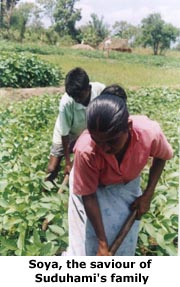
18th June 2000
Front Page|
News/Comment|
Editorial/Opinion| Business|
Sports|
Sports Plus| Mirror Magazine

![]()

- Wonder bean
- A prize catch
- Stop, look and create
- She fights back in fury
- Kala Korner - By Dee Cee
- Mind your words - A Taste of Sinhala (22)
- Dramatic sounds of east, west
- World of warring words
- D.R. Wijewardene Memorial Award
- Light for the poor
- Murder madness and love of words
- It's a breeze, climbing trees!
- Diverse beauty in heart of Europe - Travel
- News 100 years ago
- Jumbo mumbo
- I was boiled, grilled and cooked - Down memory lane
- If the dogs cannot get the foxes… - Thoughts from London
- Protecting the gods' own village
- Letters to the editor








Wonder bean
Will soya become the second staple food?
By Feizal Samath
Will soya be Sri Lanka's wonder crop of the new
century? Will it become the country's staple food, after rice, and reduce
dependence on flour imports from the United States? "I hope so,"
laughs Mohan Ratwatte, Production Director at Plenty Foods (Pvt) Ltd, Sri
Lanka's only mass producer of soya bean and soya products. "I hope
so." 
Dozens of farmers in Dambulla, thanks to the efforts of this company, are mixing their rice crop with soya and harvesting green fields in this rugged district.
The firm, which in 1996 acquired Plenty Canada Foods, a Canadian-based non-governmental organization propagating soya as a cholesterol-free, high protein food with financial help from the Canadian government, has produced a range of soya-based products that is fasting catching on amongst reluctant Sri Lankan consumers.
The Canadian firm introduced soya in 1992 in small plots in dry zone areas in Dambulla, and went on to make soya oil and two protein-based foods at its factory in Pallekelle - all on a small scale.
Since then, Plenty Foods — now part of the Colombo Link Engineering Group — has expanded production and the range of products, and grown the bean in other areas. "We want to popularize soya not only because of its nutritional content but also because it is the cheapest form of protein for our people," said Ratwatte at the company's Colombo headquarters. Most of Sri Lanka's protein intake comes from meats, which is too expensive for middle and lower classes.
Farmer Punchirala Jayaratne used to grow a mix of chillie and rice on his one hectare plot of land but switched to soya and rice when told production costs were much less and returns were higher.
"I grow a mix of soya and rice throughout the year," he said, digging his field at Meegaswewa, about 50 kilometres off Dambulla. "Soya is easier to grow than paddy and needs less attention as long as the ground is wet and the seed is good." Profits have risen by 11/2 times since he started growing soya three years ago.
Farmers find soya growing easier and less strenuous as the fields require manure only twice during the season. Soya is a three-month crop.
In an adjoining field, Herahamige Vallihami prepares for the harvesting season helped by her two grandchildren, both of whom she is raising. Vallihami's husband died of cancer two years ago. Her son-in-law died at the hands of government forces about 10 years ago during the JVP insurrection.
Her troubled daughter committed suicide soon afterwards.
Since then she has cared for the two children, who help her in the field after school. "It is a hard life but soya brings us slightly better returns than other crops," Vallihami said. The family eats only rice and vegetables and cannot afford meat or eggs.
Most of the 2,000-odd soya farmers across the north central region have a common story to tell - poverty, failed crops, family problems and young men joining the war.
Vallihami's son is in the army, while another farmer Suduhami Chandralatha's 18-year-old son wants to join up. "He wants to join the navy because there are no others jobs and farming is not a lucrative profession. We are very poor," she said, adding that they were pinning their hopes on soya production.
Jayantha Dharmasiri, an extension officer at Plenty Foods' field headquarters in Madatugama, near Dambulla, says the crop is grown on around 700 hectares and is gaining popularity.
He said seeds were purchased from some farmer plots at 30-35 rupees a kilo. "We test the plot and take only good quality seeds," Dharmasiri said, adding the seeds are then given to farmers free. "We provide a lot of other inputs like fertilizer on credit and other financial needs," he said.
The Link group got involved in the soya industry in 1996, more as a social commitment than as a commercial venture. "Yes, there is a certain element of profitability in any business but I believe the objective of the directors of the group was to get involved in a food product aimed at the middle and lower middle classes. We were looking at the social angle more than the returns," said Plenty Foods' Ratwatte.
When the Canadians wanted to sell the soya business, the Link group grabbed the offer which nicely linked with the natural products they were producing like herbal medicines, balms and toothpaste. The company was expanding from an exclusively engineering firm.
"We wanted to provide good, natural products for our people from indigenous sources instead of relying on imported food," Ratwatte said. The company is bucking globalization trends by gradually producing other crops like corn instead of importing it, as it did earlier.
Plenty Foods uses corn, green gram, kurakkan and rice in all its soya-based products. Corn imported from Australia by the company at the inception is now produced locally in large quantities. "We are growing corn of a much better variety than the imported product," Ratwatte noted.
The company's flagship product is Samaposha, a cereal aimed at children over two years, pregnant mothers, sportsmen and old people because of its high nutrition content.
Plenty Foods produces 300,000 to 400,000, 200-gram packs at the moment but sales are set to reach 800,000 packs by the end of the year. "This is a very popular product," Ratwatte said. Samaposha is a combination of maize (50 per cent), soya (30 per cent), rice (10 per cent) and green gram (10 per cent) fortified with vitamins.
Company officials say medical research shows that soya, apart from being a cholesterol-free food, also has cancer reducing agents. The company's soya-based flour — which has a 20 per cent soya/80 per cent kurakkan base - is snapped up by diabetic patients and is also welcomed by the medical profession.
The company still promotes products popularized by the Canadians like a pro-soya powder which could be used as a coconut milk substitute for curries, soya meat and soya oil but is staking its future on a range of easy-to-eat foods like Samaposha, soya cookies, soya soup and soya wheat noodles. It also produces kurakkan flour, rice flour with 12.5 per cent soya, and wheat soya with 28 per cent soya input.
"All our foods have a soya content which instantly makes it high in nutrition content. Also all our food comes from 99.9 per cent local inputs with only the fortified vitamin content from abroad," Ratwatte said.
Plenty Foods has received a lot of support from government research agencies like the Institute of Food Technology and the Food Research Institute, where much of the research on new products was done. The University of Peradeniya's agriculture research division was able to develop Innoculum, a crystal-like organic substance used to increase the nitrogen content in soya fields. Earlier this was imported from Thailand.
"In fact very little or no fertilizer is needed in soya growing," said Ratwatte.
The company is the only mass soya bean producer in Sri Lanka, apart from having a vast production base for corn and green gram.
![]()
Front Page| News/Comment| Editorial/Opinion| Plus| Business| Sports| Sports Plus| Mirror Magazine
Please send your comments and suggestions on this web site to

